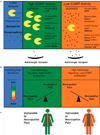Janus molecule I: dichotomous effects of COMT in neuropathic vs nociceptive pain modalities
- PMID: 22483297
- PMCID: PMC3698056
- DOI: 10.2174/187152712800672490
Janus molecule I: dichotomous effects of COMT in neuropathic vs nociceptive pain modalities
Abstract
The enzyme catechol-O-methyltransferase (COMT) has been shown to play a critical role in pain perception by regulating levels of epinephrine (Epi) and norepinephrine (NE). Although the key contribution of catecholamines to the perception of pain has been recognized for a long time, there is a clear dichotomy of observations. More than a century of research has demonstrated that increasing adrenergic transmission in the spinal cord decreases pain sensitivity in animals. Equally abundant evidence demonstrates the opposite effect of adrenergic signaling in the peripheral nervous system, where adrenergic signaling increases pain sensitivity. Viewing pain processing within spinal and peripheral compartments and determining the directionality of adrenergic signaling helps clarify the seemingly contradictory findings of the pain modulatory properties of adrenergic receptor agonists and antagonists presented in other reviews. Available evidence suggests that adrenergic signaling contributes to pain phenotypes through α(1/2) and β(2/3) receptors. While stimulation of α(2) adrenergic receptors seems to uniformly produce analgesia, stimulation of α(1) or β receptors produces either analgesic or hyperalgesic effects. Establishing the directionality of adrenergic receptor modulation of pain processing, and related COMT activity in different pain models are needed to bring meaning to recent human molecular genetic findings. This will enable the translation of current findings into meaningful clinical applications such as diagnostic markers and novel therapeutic targets for complex human pain conditions.
Figures


References
-
- Segall SK, Nackley AG, Diatchenko L, Lariviere WR, Lu X, Marron JS, Grabowski-Boase L, Walker JR, Slade G, Gauthier J, Bailey JS, Steffy BM, Maynard TM, Tarantino LM, Wiltshire T. Comt1 genotype and expression predicts anxiety nociceptive sensitivity in inbred strains of mice. Genes Brain Behav. 2010;9(8):933–946. - PMC - PubMed
-
- Mogil JS, Wilson SG, Bon K, Lee SE, Chung K, Raber P, Pieper JO, Hain HS, Belknap JK, Hubert L, Elmer GI, Chung JM, Devor M. Heritability of nociception I: responses of 11 inbred mouse strains on 12 measures of nociception. Pain. 1999;80(1–2):67–82. - PubMed
-
- Mogil JS, Wilson SG, Bon K, Lee SE, Chung K, Raber P, Pieper JO, Hain HS, Belknap JK, Hubert L, Elmer GI, Chung JM, Devor M. Heritability of nociception II'Types' of nociception revealed by genetic correlation analysis. Pain. 1999;80(1–2):83–93. - PubMed
Publication types
MeSH terms
Substances
Grants and funding
LinkOut - more resources
Full Text Sources
Other Literature Sources
Miscellaneous
